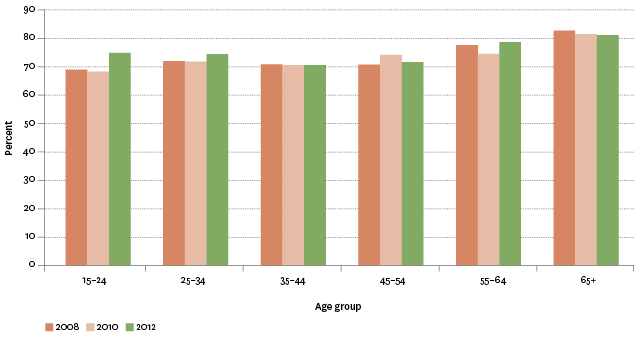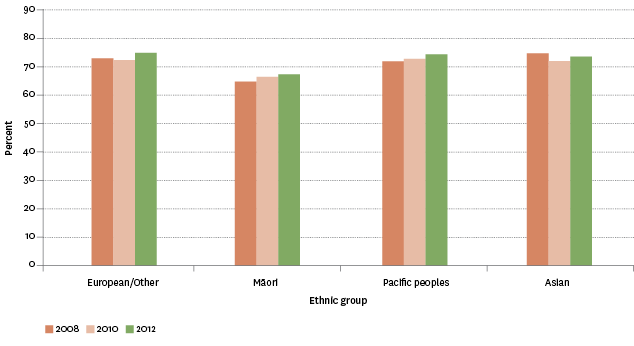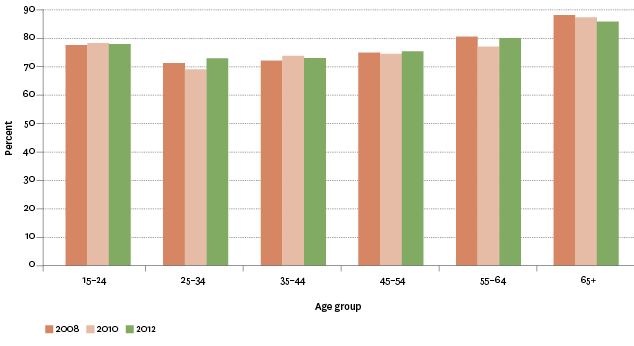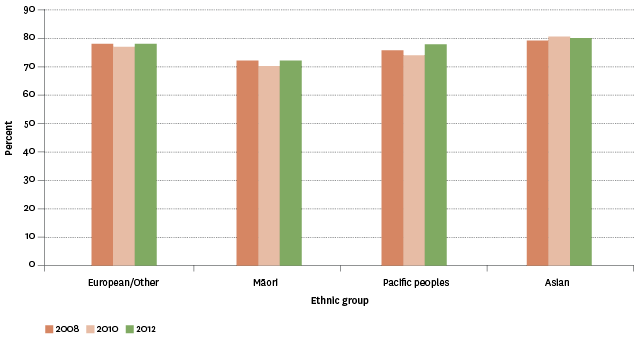Social connectedness
Contact with family and friends
Definition
The proportion of the population aged 15 years and over who said the amount of contact they had with family and friends who didn't live with them was “about right”.
RelevanceTop
Families and friends are key sources of social support and give people a sense of belonging. Staying in touch with family and friends who live elsewhere helps maintain social connectedness between households and across geographical boundaries. Contact includes face-to-face meetings as well as telephone calls, letters, emails, texting, and other forms of electronic communication.
1. Contact with familyTop
Current level and trendsTop
The proportion of people who said they didn't have enough contact with family who did not live with them fell between 2008 and 2012 (from 25.0 percent to 22.9 percent), while the proportion of people who said they had too much contact with non-resident family remained stable (2.1 percent in 2008 and 2.5 percent in 2010 and 2012).
Table SC2.1 – Proportion of population by amount of contact with
non-resident family, 2008–2012
| Amount of contact | 2008 | 2010 | 2012 |
|---|---|---|---|
| Too much | 2.1 | 2.5 | 2.5 |
| About the right amount | 73.0 | 72.8 | 74.6 |
| Not enough | 25.0 | 24.7 | 22.9 |
Source: Statistics New Zealand, New Zealand General Social Survey
Age and sex differencesTop
People aged 65 years and over (80.7 percent in 2012) were most likely to say the amount of contact they had with non-resident family was about right. This was true across all three survey periods. In 2008 and 2010, people aged 15–24 years were least likely to say the amount of contact they had with non-resident family was about right, but this proportion increased from 67.8 percent in 2010 to 74.4 percent two years later. There was a similar pattern for 25–34 year olds – the proportion for this group increased from 71.6 percent in 2008 to 74.4 percent in 2012. In 2012, the 35–44 year age group was least likely to say the amount of contact they had with non-resident family was about right (70.1 percent). This proportion remained stable across the three surveys.
The proportion of males and females who said the amount of contact they had with non-resident family was “about right” was similar. In 2012, 73.8 percent of males said the amount of contact with non-resident family was about right, compared with 75.3 percent of females. In 2010, the proportions were the same for males and females (72.8 percent), while in 2008 the figures were 72.5 percent for males and 73.4 percent for females.
Figure SC2.1 – Proportion of population aged 15 years and over whose contact
with non-resident family was “about right”, by age group, 2008–2012

Source: Statistics New Zealand, New Zealand General Social Survey
Ethnic differencesTop
In 2012, people in the European/Other group (75.6 percent), Pacific peoples (75.2 percent) and people in the Asian ethnic group (74.4 percent) were most likely to say the amount of contact they had with family who didn't live with them was about right. Māori were least likely to say the amount of contact they had with non-resident family was about right (68.0 percent).
Figure SC2.2 – Proportion of population aged 15 years and over whose contact
with non-resident family was “about right”, by ethnic group, 2008–2012

Source: Statistics New Zealand, New Zealand General Social Survey
Socio-economic differencesTop
As material wellbeing decreases, the proportion of people who said their amount of contact with non-resident family was about right also decreases. In 2012, 80.9 percent of those in the higher material wellbeing index category said the amount of contact they had with family who didn't live with them was about right, while for those in the lower material wellbeing index category, the proportion was 62.3 percent.
There were no differences by personal income. Three-quarters (75.1 percent) of those with personal incomes of between $30,001 and $70,000 said the amount of contact they had with non-resident family was about right, while the figures for those who earned under $30,001 and over $70,000 were 74.2 percent and 74.5 percent respectively.
Family type differencesTop
People living in sole-parent families (66.7 percent) were less likely than other family types to say the contact they had with family who didn't live with them was about right. In 2012, 73.8 percent of people living in a couple with children, 76.6 percent of people who are not living in a family nucleus and 77.1 percent of people living in a couple without children said this.
Migrant status differencesTop
In 2012, 75.6 percent of New Zealand-born people said the amount of contact they had with non-resident family was about right. The proportions for longer-term migrants (71.7 percent) and migrants who had arrived in New Zealand within the last five years (73.7 percent) were similar.
Regional differencesTop
In 2012, Canterbury (78.7 percent) and Bay of Plenty (77.1 percent) had the highest proportions of people who felt the amount of contact they had with non-resident family was about right. Tasman/Nelson/Marlborough/West Coast had the lowest proportion who felt this way (70.1 percent).
2. Contact with friendsTop
Current level and trendsTop
The proportion of people who said they did not get enough contact with non-resident friends remained relatively consistent over the three survey periods, as did the proportion of people who said they got too much contact with friends who didn't live with them.
Table SC2.2 – Proportion of population by amount of contact with
non-resident friends, 2008–2012
| Amount of contact | 2008 | 2010 | 2012 |
|---|---|---|---|
| Too much | 2.2 | 1.9 | 1.9 |
| About the right amount | 77.0 | 76.5 | 77.3 |
| Not enough | 20.8 | 21.6 | 20.7 |
Source: Statistics New Zealand, New Zealand General Social Survey
Age and sex differencesTop
In 2012, people aged 65 years and over (85.7 percent) were the most likely to say the amount of contact they had with friends who didn't live with them was about right. This was true across all three survey periods. Those aged between 25 and 54 years were least likely to say they felt their contact with non-resident friends was about right (between 72.9 and 75.3 percent).
The proportion of males and females who said the amount of contact they had with non-resident friends was about right was similar. In 2012, 78.1 percent of males said the amount of contact with friends who didn't live with them was about right, while 76.7 percent of females felt the same way. In 2010, the proportions were 78.3 percent and 74.8 percent respectively; and in 2008 the figures were 77.7 percent and 76.3 percent respectively.
Figure SC2.3 – Proportion of population aged 15 years and over whose contact
with non-resident friends was “about right”, by age group, 2008–2012

Source: Statistics New Zealand, New Zealand General Social Survey
Ethnic differencesTop
In 2012, Māori were least likely to say the amount of contact they had with friends who didn't live with them was about right (73.6 percent). People in the Asian ethnic group were most likely to report this (80.2 percent).
Figure SC2.4 – Proportion of population aged 15 years and over whose contact
with non-resident friends was “about right”, by ethnic group, 2008–2012

Source: Statistics New Zealand, New Zealand General Social Survey
Socio-economic differencesTop
As material wellbeing decreases, the proportion of people who said the amount of time with non-resident friends was about right also decreases. In 2012, 83.7 percent of those in the higher material wellbeing index category said this, compared with 67.0 percent of those in the lower material wellbeing category.
Those with lower incomes were more likely than those with higher incomes to say the amount of contact they had with non-resident friends was about right (78.8 percent of those who earned $30,000 or under, compared with 73.9 percent of those who earned over $70,000, in 2012).
Family type differencesTop
In 2012, people living in families without children (79.5 percent of couples without children and 81.3 percent of those not in a family nucleus) were more likely than people living in families with children (74.7 percent of people living in a couple with children and 74.6 percent of people in sole-parent families) to say their contact with non-resident friends was about right.
Migrant status differencesTop
In 2012, 77.0 percent of New Zealand-born people said the amount of contact they had with family who didn't live with them was about right. The figures for longer-term migrants (78.6 percent) and migrants who had arrived in New Zealand (77.0 percent) within the last five years were similar.
Regional differencesTop
In 2012, Auckland (80.1 percent) and Southland (79.6 percent) had the highest proportion of people who felt their amount of contact with non-resident friends was about right. Otago had the lowest proportion who felt this way (72.6 percent).
Data for this section can be found at: www.socialreport.msd.govt.nz/documents/2016/sc2.xlsx

